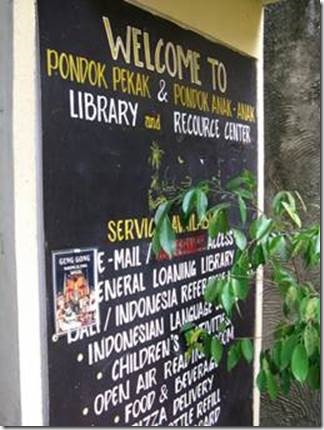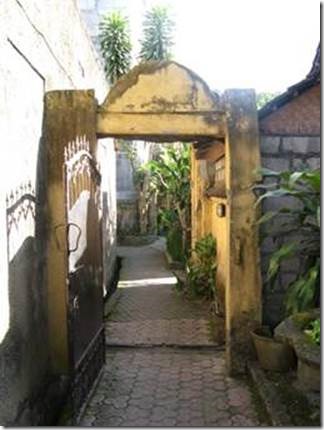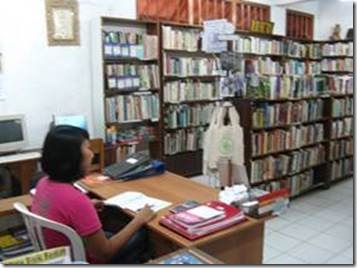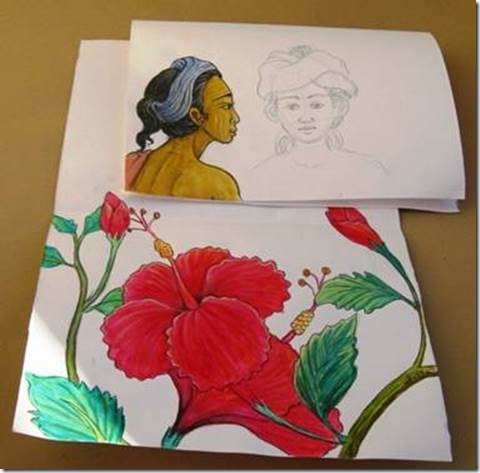In eat pray love , Elizabeth Gilbert had written about the Ubud “public” library, so I kept an eye out for it. Since it’s in the center of town, has a huge sign and was not far from our hotel, we found it easily. Randal and I were there each day to check email, browse the “for sale” books; and I took a Balinese traditional painting class. It was great; the best library I have found on our travels so far. Though only 2 rooms, one small and one tiny, it was quite similar to my own library at home except in Bali one removes one’s shoes before entering. (At least I did the last time I was there and thought to notice everyone had left shoes outside. Tourists are allowed shoes, but locals remove their sandals before entering the very clean tiled establishments. With sneakers it’s a pain with the laces and all.) Here is the description from the library’s small brochure.
A Bit About Pondok Pekak
(Pondok Pekak = Grandfather’s little resting house in the rice fields)
Pondok Pekak Library and Learning Center was founded in 1995 by a woman who loves to read and believes that every town should have a library. With the support of her husband and his family, the library was built as an addition to his family compound. The idea was inspired by the family grandfather, Pekak Mangku, whose passion for reading, learning and helping others established his reputation as a respected priest, healer and advisor until the day he died in 2001. Built in the 1970’s on the very spot in the rice fields where his own ‘pondok’ once stood, this home has always been referred to by family and community as ‘The Pondok’. In honor of this tradition and this man, the library was named ‘Pondok Pekak’.
Since 1995 the library has grown rapidly, primarily servicing travelers and expatriates who already have a love and desire for books. The goal, however, is to introduce “library and reading culture’ to local children who have not had the access to books many foreigners take for granted. As a result, and with help of many friends, Pondok Pekak in now able to provide these children with a library of their own, full of colorful and interesting children’s books.
As a privately funded organization, survival is a constant, creative challenge. We strive for self-sufficiency by offering a selection of services, all of which help toward supporting this project. We encourage you to help us along by using these services – joining the library, study language or an art form; enjoy a meal; refill your water bottle. Donations of funds, books, time and materials are also appreciated.
The sign was on the street on the far side of the soccer field that was located in the center of town. You walked past the sign down a short alley housing a restaurant and turned left. I believe that the family compound was to the left of the wall. At the end of the short alley you turn right and there you are. Sings all along the way pointed to the library.
They were open 9 to 9 every single day! This young woman worked every day except Sunday. She was pleasant, helpful and professional. In this photo she is signing me up for my Balinese traditional painting class. It was 3 hours and cost 200,000rp, about $23. There were 4 internet terminals, 2,000 rp 25 cents for 10 minutes. That was cheaper and better than the internet café near our hotel. In their “for sale” books, I found a very used copy of West With the Night by Beryl Markham. It is Randal’s favorite book of the moment but he had given his last copy to Tony Parkinson back in Romblon. This copy had been given to Penny in August 1987 for her birthday by Misha, Knengi and Kadiato? ( a photo of a happy group is taped above the words, but it is too faded to really see.) In August 2007, Tim gave the book to Patricia to inspire her writing. I gave it to Randal September 2008, just because he likes the book. It cost me 40,000 rp. About $4.25. It cost $12.50 in 1983 when this edition was published. The original copyright is 1942.
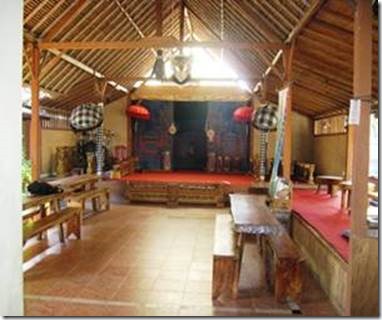 In the building is a small room with the adult books and internet, the place to fill water bottles and the for sale books. Just outside the library room is a bathroom, stage area, work tables for classes, and a small kitchen where they made the wonderful smelling snacks you could buy. Also some artwork was displayed. I had my class at the table on the left. You can see my black backpack.
In the building is a small room with the adult books and internet, the place to fill water bottles and the for sale books. Just outside the library room is a bathroom, stage area, work tables for classes, and a small kitchen where they made the wonderful smelling snacks you could buy. Also some artwork was displayed. I had my class at the table on the left. You can see my black backpack.
Upstairs was a tiny children’s library.
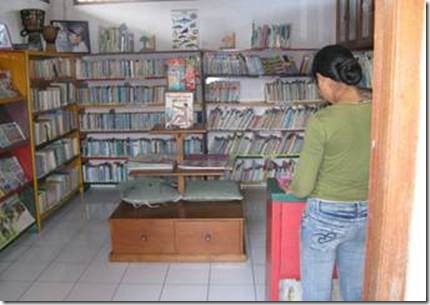 I had my sneakers on so didn’t go in. From what I could see, most titles were in English.
I had my sneakers on so didn’t go in. From what I could see, most titles were in English.
I really, REALLY liked the little library and hope that where ever we end up when our cruising days are over we live somewhere with a library like that.
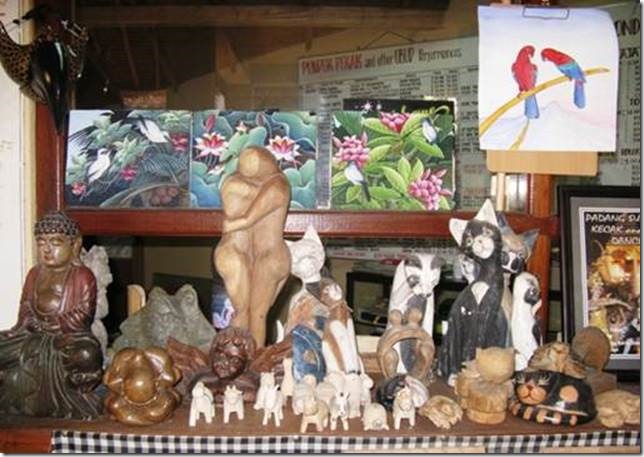 Some examples of Balinese traditional painting and woodcarving. Amazingly I bought a cat like the tall one with white ears while in Kota Kinabalu. Much of what we saw being made in the small shops is actually exported so that’s why you can buy things like the cat with the striped tail in the US.
Some examples of Balinese traditional painting and woodcarving. Amazingly I bought a cat like the tall one with white ears while in Kota Kinabalu. Much of what we saw being made in the small shops is actually exported so that’s why you can buy things like the cat with the striped tail in the US.
My teacher, Pak Sulendra, did most of what you see. We did the woman first and then the flowers. I say we because I actually did help. He drew a picture of the woman on one sheet of paper and I drew on this one, and then he fixed what I drew. Then he taught me how to go over the pencil with an drawing pen….very slowly! Then we started to put down the color. It is acrylic mixed with water. He would show me and then I would finish. Before we painted the woman’s hair you could see the pen lines and I am sorry they all were painted over. Up close you can see them and it gives the hair detail. The scarf still has visible ink lines. The lines on her face and the bit of white in her hair represent age, But with no saggy chin so I’m not sure that I see an older woman. Maybe Balinese women don’t get saggy chins. I also had trouble with the hibiscus because I didn’t know what they looked like in real life. My teacher obviously does. We drew then inked then put down a red wash leaving some white. Then we added yellow, then more red, then the green. I loved watching it develop layer after layer of color. By the end of the three hours I was quite tired. But I learned patience and how to use the acrylic paint that Dorothy Nagle gave me back in Subic. I hadn’t mixed in enough water. He mixed in lots of water for the initial washes.
That afternoon I followed the map Pak Sulendra had drawn for me to the local art supply store. I bought the same drawing pens and 2 brushes like he had. One can only hope (and practice!)

